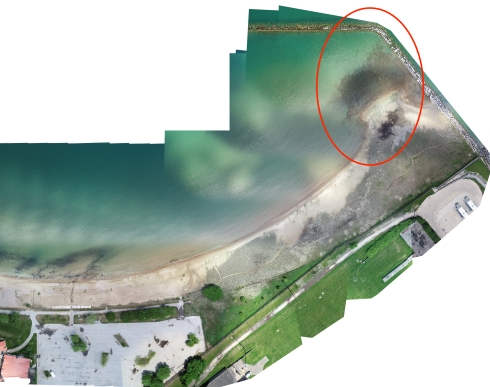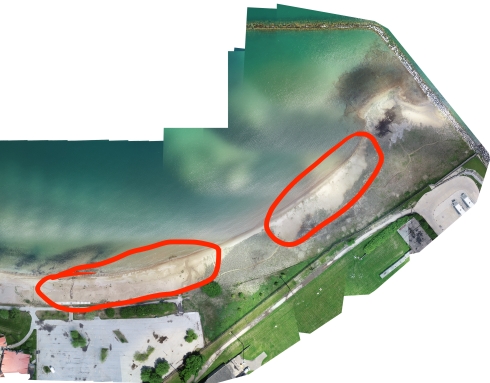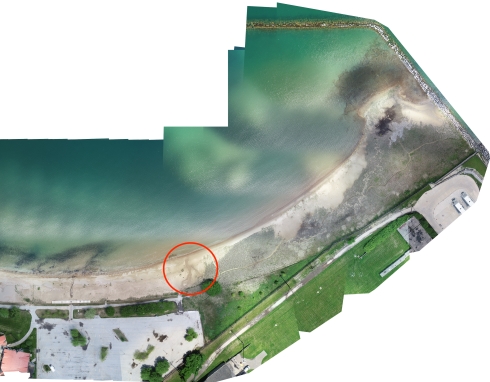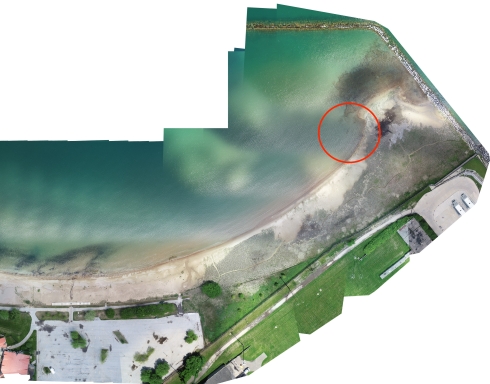Due to COVID-19, the summer field season for researchers, land managers, and engaged citizens is an odd one this year. Many decades-long research programs will be missing a 2020 datapoint, especially as a result of travel restrictions. But even at our local Rainbow Beach Dunes, we can’t do our volunteer stewardship and monitoring work owing to its lakefront location — even though this year presents even more unusual conditions owing to its lakefront location.
How is RBD feeling this double whammy?
Because lakefront beaches in the city of Chicago are closed due to COVID-19, RBD isn’t open to the public or volunteer stewardship. The unfortunate irony is that this is precisely the time the site is undergoing massive changes in the landscape due to very high lake levels.
The loss of beach, dune, and vegetation is a result of Lake Michigan’s encroachment and can be seen clearly in this aerial photo of Rainbow Beach taken by the Chicago Park District in May.

Aerial view Rainbow Beach, May 2020
You might recall that in the far right corner by the breakwater (circled below), the sand used to be all the way out to the bend, back in the olden days (see also historic photos below, from ~2007-2012).
What used to be totally covered in native sand prairie and dune vegetation is now basically new “beach”:

And one of my favorite features of the dunes — the huge, healthy and proliferating mats of arctic bearberry spreading out over 10s of meters — has been ripped up by the lake, and rolled into long tangles of stems, at the very edge of this new beach.
We also lost the panne, which was full of rare wetland plant species, including the incomparable fringed gentian and one of my favorites, grass of parnassus. Now they’re covered with sand, perhaps to emerge again in the future if the seedbank stays viable!

And the swale, which was rid of the invasive species Phragmites and full of the lovely native Kalm’s St. Johns’s Wort, is literally underwater! You can see some of the dead shrubby branches poking up out of the water if you look real close:

But as we all know, the water levels of Lake Michigan are variable and therefore ecosystems that are shaped by it are dynamic. That’s right, Lake Michigan dunes are DYNAMIC, here at RBD in Illinois but also around the Lake, in Indiana and Michigan! These shifting sands and shorelines are the forces this ecosystem has had to contend with for the last 10,000 years – whether it’s relatively undisturbed by humans, as in the National and State Parks, or it’s literally constructed by humans, as in Rainbow Beach Dunes.
So what can we expect next from our dynamic ecosystem?
Well, we’ve got a new panne starting! With the expertise of the natural areas contractors from Cardno, this was foreseen and Jack Pines, lovers of this groundwater-fed wetland micro-habitat, were planted in 2019! You can see all 3 of them in the aerial photo, right next to this new panne wetland:
And these new, bare sand beaches? They’ll be colonized quickly with marram grass -the dune builder- which will pave the way for a succession of plant species, and in a few more years, we’ll once again have a foredune taller than I am.
•••
As a reminder of how the lake levels have had an effect on RBD over the last ~20 years, see below (images from Google Earth):








